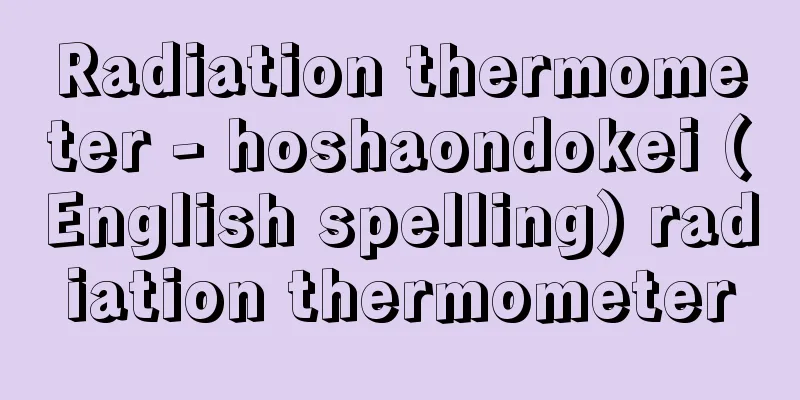Radiation thermometer - hoshaondokei (English spelling) radiation thermometer

|
A general term for an instrument that measures the temperature of an object based on the intensity of radiant energy emitted from the surface according to the object's temperature. Previously, optical pyrometers were mainly used to measure high temperatures of 1000°C or higher, and were called radiation pyrometers, but since the 1980s, advances in radiation detectors have led to the use of pyrometers that can measure temperatures from high temperatures to room temperature, and they have come to be called radiation pyrometers. They are based on Planck's radiation formula, but are classified into several categories depending on the wavelength of the radiation observed and the method of radiation measurement. The optical pyrometer measures the intensity (brightness) of radiation of a specific wavelength (usually red radiation with a wavelength of 0.65 micrometers) emitted by an object. The radiation from the light bulb in the instrument is compared with the radiation from the object with the naked eye, the brightness of the light bulb is adjusted so that the two are equal, and the temperature is read from the current at that time. This method has been used for a long time in the steel industry and other industries. Automatic types that use a photoelectric converter instead of the naked eye are also widely used and are called photoelectric pyrometers. On the other hand, there are radiation thermometers that collect radiation from the object over a wide wavelength range and calculate the temperature from the total energy. Depending on the wavelength range, they are called total radiation thermometers or infrared thermometers. This type of thermometer can measure relatively low temperatures and is expanding new fields of application as a fast-responding non-contact thermometer. It is particularly effective for measuring the temperature of moving objects, large objects, and conversely, small objects. [Mitsui Kiyoto] [References] | | |Source: Shogakukan Encyclopedia Nipponica About Encyclopedia Nipponica Information | Legend |
|
物体がその温度に応じて表面から発する放射エネルギーの強度によって物体の温度を測定する計器の総称。従来は1000℃以上の高温測定に用いる光高温計が主であり、放射高温計(radiation pyrometer)とよばれたが、1980年代から放射検出器の進歩によって高温から常温付近まで測定できるものが利用されるようになり、放射温度計とよばれるようになった。プランクの放射公式を原理とするが、観測する放射の波長や放射測定の方法によっていくつかに分類される。 前記の光高温計は、対象物が発する放射のうち、特定の波長の放射(普通は波長0.65マイクロメートルの赤色)の強度(輝度)を測定するもので、計器内の電球からの放射と対象物からの放射とを肉眼で比較し、両者が等しくなるよう電球の明るさを調節して、そのときの電流から温度を読み取る方式が、製鉄業などで古くから用いられている。肉眼のかわりに光電変換器を用いた自動式のものも広く用いられ、光電高温計ともよばれている。一方、広い波長域にわたって対象物からの放射を収集し、その全エネルギーから温度を求める方式の放射温度計があり、波長領域によって全放射温度計または赤外線温度計とよばれている。この方式のものは比較的低温度も測定することができ、応答の速い非接触温度計として新しい応用分野を広げている。とくに、運動する物体や巨大な物体、逆に微小な物体の温度計測に効果的に用いられる。 [三井清人] [参照項目] | | |出典 小学館 日本大百科全書(ニッポニカ)日本大百科全書(ニッポニカ)について 情報 | 凡例 |
Recommend
Sakigake (pioneer) - pioneer
It is also written as "sento". It means ...
Prunus padus (English spelling) Prunuspadus
…[Hiroshi Aramata]. … *Some of the terminology th...
despotisme legal (English)
…Representative monarchs of this type include Fre...
Palace
〘 noun 〙 (palace) ① palace. Royal palace. ※Amerika...
Qashqā'ī (English spelling)
A Turkic tribe in the Fars region in southwestern ...
Regis - Jean Baptiste Régis
A French Jesuit. His Chinese name was Lei Xiaosi....
Language
…These tissues, along with the palatine tonsils a...
Olein alcohol (English spelling) oleinal cohol
…Olein alcohol is also called olein alcohol. It i...
Vernet, H.
...French painter. Born in Avignon. He lived in I...
Hub - Habu (English spelling) habu
It is a poisonous species of the genus Habu in th...
Ernst Dronke
1822‐91 German social novelist. Born in Koblenz as...
《Bride of Abydos》
...This tragic love story, which originated in th...
tablemount
… abyssal gap - a narrow gap in a ridge or rise. ...
Egeria densa (English spelling) Egeriadensa
...In its native habitat, the broken male flowers...
Palmoplantar pustulosis
What is the disease? It is a chronic disease that...









